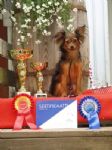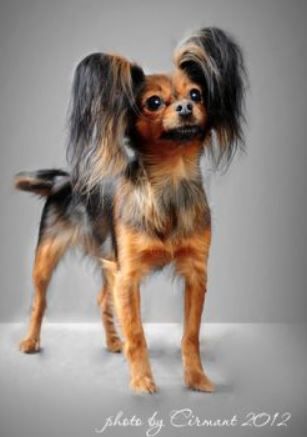Breed History
BREED HISTORY:
The Russian (Russkiy) Toy is one of the smallest dog breeds in the world. At their General Assembly in 2006 the 'Russian Toy' in its two varieties finally became FCI recognized. In accordance with the FCI (Federation Cynologique Internationale) breed standard males and females are to be 22 – 27 cm in height and weigh up to 3 kg. The preferable height is 25 cm and preferable weight is 2.3 kg. The Russian Toy is generally good in nature and loves to run and play. They thrive on human companionship and will let you know if they are feeling neglected. There are two varieties within the breed – long coat and smooth coat.
AUSTRALIA- HISTORY:
In late 2008, early 2009 the first Russian Toy dogs were brought into Australia by Christa Guntendorfer. At that time, the breed was not recognised in Australia. Christa worked with the Australian National Kennel Club Ltd for a number of years, to have the Russian Toy (long coat/short coat) breed standard recognised within Australia. In 2012 the first Russian Toy litter puppies were registered with the ANKC (Australian National Kennel Council).
The first Russian Toy shown in the exhibition ring in Australia was at the Lockyer Valley Kennel Club show at Durack (Queensland) on the 1st January 2013. The dog was G'Minna De La Prunelliere (imported France) winning Best of Breed and Junior exhibit in Group 1 (Toy Group). Minna (Ben Rafferty- Benboochka Kennels) also became Australias first Russian Toy Australian show Champion in April 2013.
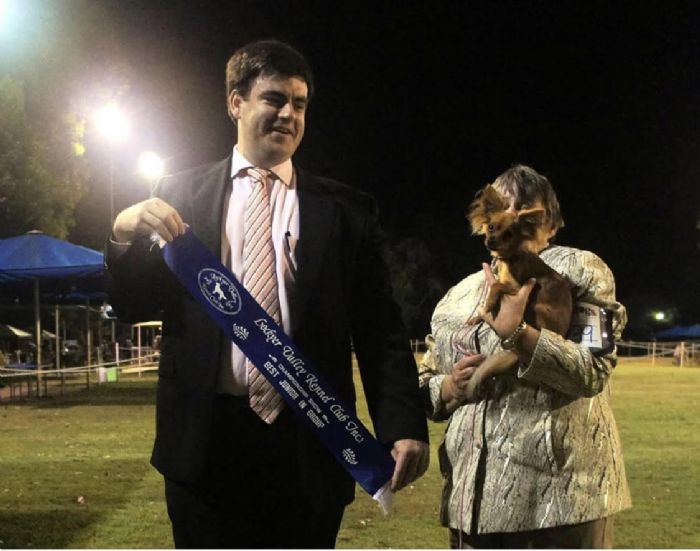
neuter12Oct11.jpg)
Aust CH G'Minna De La Prunelliere (Import France)
The first Russian Toy Australian Grand Champion was Ooo Fab Falcoon Surprised Us All (import Sweden). Barnaby was imported from Sweden and owned by Ben Rafferty.
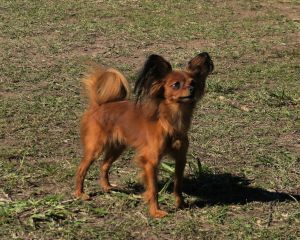
_10Nov11.jpg)
Aust Grand CH Ooo Fab Falcoon Surprised Us All (Import Sweden)
In 2019, the first Australian born Russian Toy Grand Champion was awarded to Benboochka Count Alucard. Jet was breed by Ben Rafferty and was owned and campaigned by Don Hunter. Jet also has achieved FCI International Championship title C.I.B. Australian Champion Tsarskaya Pechat Gamer La Valensia (pictured lower) is Jets grand father.
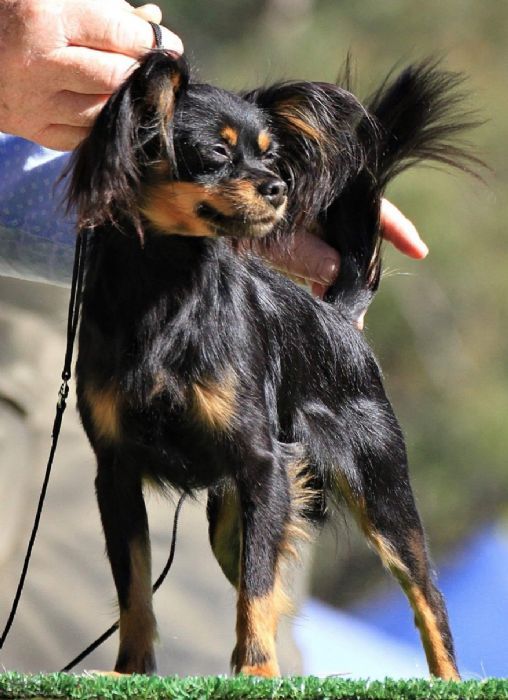
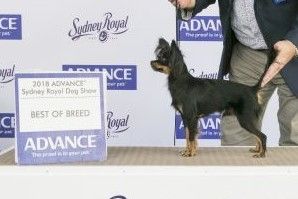
Aust Grand CH Benboochka Count Alucard
From 2016, Edelpark Kennels (NSW-Australia) has been actively promoting this sweet little breed. At Edelpark we are interested in promoting and improving the Russian Toy breed within Australia by producing excellent temperament, type and soundness. With the support and mentoring of Lee Thomson (Lenishta Kennels - Victoria) and Ben Rafferty (Benboochka Kennels - Queensland).
Edelpark Kennels foundation Russian Toy (Long Coat) were.
Female - Benboochka Mirrie Dancer.
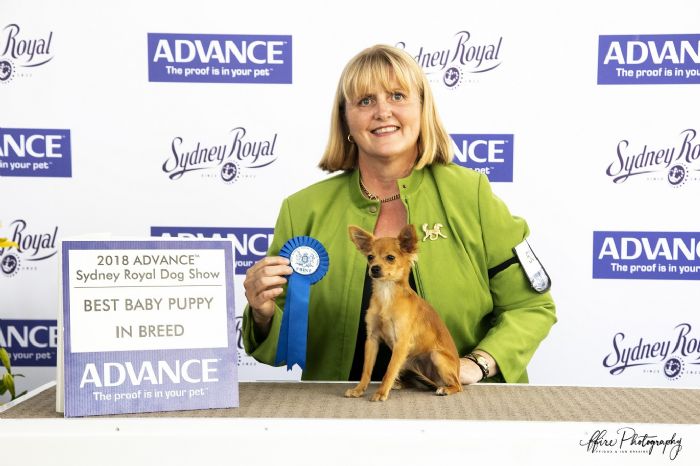
Male - Australian CH Tsarskaya Pechat Gamer La Valencia (imported Russia)
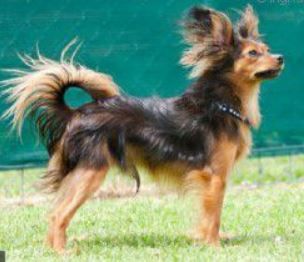
Aus CH Tsarskaya Pechat Gamer La Valensia (imported Russia)
MOTHER: BLR. GR. CH. EE. CH. LTU. CH. LVA.CH. RUS.CH.FIN.GR CH BALT CH Galaxie D'Amour Baronnesa
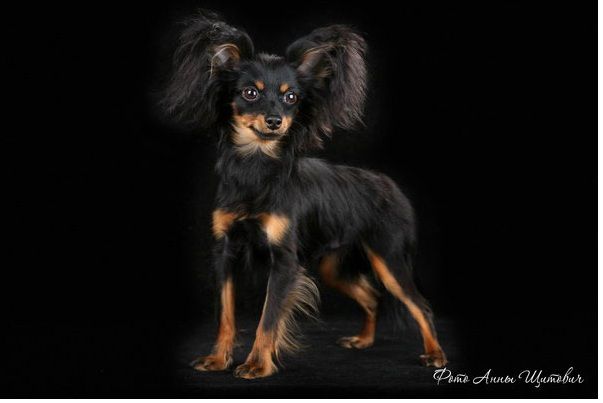
FATHER: RU.JR CH Utonchennyj Aristokrat Ot Valensii
BREED BACKGROUND:
The Russian Toy is a toy breed with a lineage that dates back to the Russian aristocracy. The breed was developed in isolation when the Russian people were under Communist rule, by breeders passionate to the breed. Then, the only breeding of dogs encouraged was for the ‘benefit of the national economy’. It is a tribute to the early Russian Toy enthusiast that we now have the Russian Toy (Smooth Coat) and Russian Toy (Long Coat) today.
In the 1700s when purebred dogs were beginning to emerge, Russia was not isolated. Like other European countries they had their share of purebred dogs. The first evidence of English-style terriers in Russia can be seen in the Museum of Zoology in Saint Petersburg. Dated 1716–1726 the taxidermy preserved terrier has a sign which reads "This dog is a short hair terrier named Lizetta”. It personally belonged to the Russian Emperor Peter the Great (Tzar Peter the first).
RUSSIAN (RUSSKIY) TOY - SMOOTH
The smooth coat is the older of the two Russian Toy breed types. According to some accounts, records indicate that eight smooth haired Russian Toys competed in a dog show in St. Petersburg as far back as 1874. The more generally accepted first reference to the breed appears in May 1907 when 11 Russian Toys were shown at an exhibition in St. Petersburg.
The communist revolution of 1917 nearly exterminated the Russian Toy. The breed was nearly wiped out twice; first in the 1920s with the rise of Communism due to the toy dog's traditional link to the aristocracy and again in the 1990s with the influx of foreign breeds following the fall of the Iron Curtain.
During the Russian government upheaval, breeding of dogs for companionship was brought to a halt and the fate of the Russian Toy was uncertain. The breed was forbidden in “official” breeding programs. The only breeds which were encouraged were large guard dogs created under Communist rule for military purposes. A dedicated group of breeders maintained small kennels of Russian Toys, with a small number being exhibited prior to World War II (1939 to 1945) .
Immediately after World War II, a few Russian soldiers brought small dogs (such as German miniature Pinchers and English Toy Terrier – black and tan) with them when they returned home. They were deemed to be ‘decorative dogs’ and were considered useless under Stalins rule. Although Stalin died in 1953, the Communist rule remained and importation of dogs from the ‘west’ was prohibited. Russia was separated from the west by thousands of kilometres (miles) of fencing, referred to as the ‘Iron Curtain’.
By the mid to late 1950s the utilitarianism of the early communist state began to relax and there was a concentrated effort to return the Russian Toy Dog to prominence in the Soviet Bloc. By 1960, 76 dogs were entered into an exhibition. The first standard for the two Russian Toy varieties (smooth coated and long coated) was written in 1966 and authorized by the Ministry of Agriculture (Russia).
Through the 1970s and early 1980 prior to the dismantling of the “Iron Curtain” both the long coated and smooth coated varieties continued to develop with little to no influence from the ‘west’. However, the fall of the “Iron Curtain” saw an influx of breeds not native to Russia and the popularity of the Russian Toy breed waned. In 1988 a new breed standard developed by Russian breeders and the Russian Kynological Federation cemented the Russian Toy Dog’s place in history.
During this period the smooth coated variety became known as the Russian Toy Terrier and the long coated variety as the Moscow Long Coated Toy Terrier, denoting the epicenter of development for the long coated dog.
RUSSIAN (RUSSKIY) TOY - LONG
The smooth coat type is the older of the two breed varieties, with the long coat type first appearing in 1958. Among litters of the Russian Toy Terrier (smooth), an occasional long-haired puppy was produced. ‘Chikki’ was one such dog and purchased by Evgeniya Fominichna Zharova. Zharova is known as the long-coated variety's founding breeder; as the first breeder to intentionally retain and breed a dog with a longer coat. Chikki developed an ear fringe and was mated with a female named Irma, who also had a longer coat than most smooth-coated dogs, and together they produced a litter of three long-coated puppies. Zharova developed the breed in Moscow, and so it came to be known as the Moscow Toy Terrier. The breed made its first appearance at a dog show in 1964 and the standard was set in 1966. Ten years after Chikki's birth, between 1968 and 1969, approximately 300 long-coated dogs were registered.
RUSSIAN TOY FCI REGISTRATION
During the time of the Moscow Toy Terriers' development, the FCI did not recognize any Russian breeds. As this was the first Russian breed to attempt to gain FCI recognition, the paperwork took around two years. One of the FCI's requirements was that the word 'Terrier' be dropped from its name. At their General Assembly in 2006 the ‘Russian Toy’ in its two varieties finally became FCI recognized.
